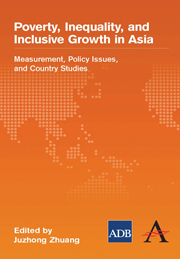Book contents
- Frontmatter
- Contents
- Foreword
- Preface and Acknowledgments
- Contributors
- Abbreviations, Acronyms, and Symbols
- Tables, Figures, and Boxes
- 1 Poverty, Inequality, and Inclusive Growth in Asia
- Part A Measuring Inequality and Poverty
- Part B Selected Policy Issues for Inclusive Growth
- 5 Inclusive Growth through Full Employment: The Role of Investment and Industrial Policy
- 6 Why is Access to Basic Services Not Inclusive?
- 7 Social Protection in Asia
- 8 Governance and Institutional Quality and the Links with Growth and Inequality: How Asia Fares
- Part C Country Studies
- Index
8 - Governance and Institutional Quality and the Links with Growth and Inequality: How Asia Fares
from Part B - Selected Policy Issues for Inclusive Growth
Published online by Cambridge University Press: 05 March 2012
- Frontmatter
- Contents
- Foreword
- Preface and Acknowledgments
- Contributors
- Abbreviations, Acronyms, and Symbols
- Tables, Figures, and Boxes
- 1 Poverty, Inequality, and Inclusive Growth in Asia
- Part A Measuring Inequality and Poverty
- Part B Selected Policy Issues for Inclusive Growth
- 5 Inclusive Growth through Full Employment: The Role of Investment and Industrial Policy
- 6 Why is Access to Basic Services Not Inclusive?
- 7 Social Protection in Asia
- 8 Governance and Institutional Quality and the Links with Growth and Inequality: How Asia Fares
- Part C Country Studies
- Index
Summary
Introduction
Economic growth in developing Asia in recent decades has been nothing short of impressive. For the region as a whole, per capita gross domestic product (GDP) in 2005 purchasing power parity (PPP) terms increased from $1,403 to $3,174 between 1990 and 2005, growing at an annual rate of 5.6%, a pace with few parallels globally and in history. This has led to substantial reductions in extreme poverty: the incidence of poverty measured at $1.25 a day declined from 52% to 27%, and at $2 a day from 79% to 54% (see Chapter 1). However, economic success on such a massive scale has not been uniform across the region. Growth has largely been driven by the People's Republic of China (PRC), India, and several Southeast Asian countries. In many parts of Asia, growth has been slow, increases in per capita income have been limited, and the incidence of extreme poverty remains high. In South Asia in 2005, for example, 43% of the population still lived below the $1.25-a-day poverty line and 76% lived on less than $2 a day. Whether and how lagging economies can catch up with the region's high performers remain a significant development challenge.
Globally, income growth has been effective in reducing absolute poverty, but less so in reducing relative poverty or inequality.
- Type
- Chapter
- Information
- Poverty, Inequality, and Inclusive Growth in AsiaMeasurement, Policy Issues, and Country Studies, pp. 268 - 320Publisher: Anthem PressPrint publication year: 2010
- 5
- Cited by



